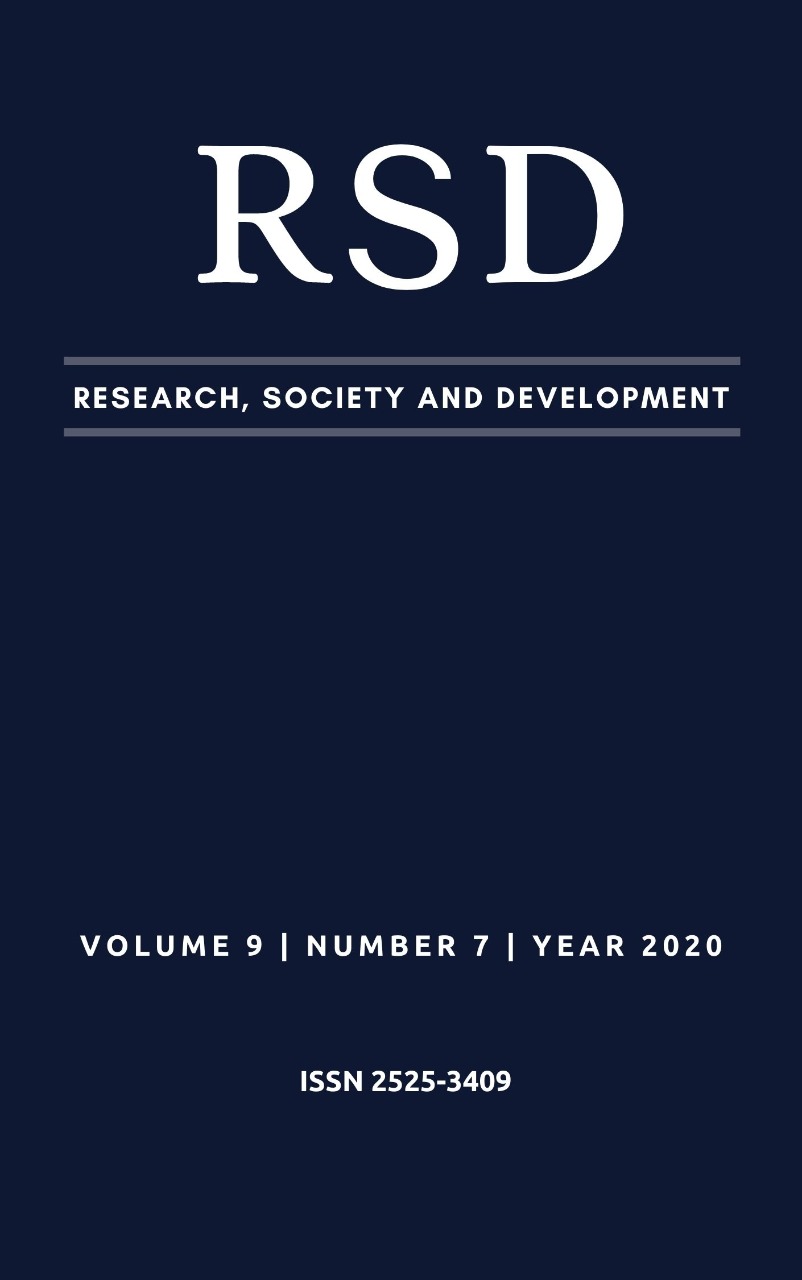Aesthetic restoration with fiberglass pin and compound resin: clinical case report
DOI:
https://doi.org/10.33448/rsd-v9i7.4899Keywords:
Aesthetics, Composite Resins, Dentistry.Abstract
Objective: To report a clinical case of the use of fiberglass pin and composite resins for oral rehabilitation of tooth 14 (upper right premolar). Case Report: A patient sought care at a private dental office complaining about a tooth with aesthetic impairment. Exposing the forms of treatment, the patient agreed to rehabilitate tooth 14 with a fiberglass pin and composite resin. It started by dismantling 2/3 of the vestibular canal to install the pin, then after its preparation, it was cemented with dual resin cement in A3 color and adapted to the root canal. Thereafter, a 37% phosphoric acid for 40 seconds was used, then the adhesive and light cured for 40 seconds. Then the crown was reconstructed with small increments photoactivated with composite resins for dentin in color A3 and enamel in color A3. A pre-finishing was done with a diamond tip and the final polishing was done after 48 hours. Conclusion: Composite resins associated with prefabricated fiberglass pins are a satisfactory alternative for the rehabilitation of endodontically treated teeth that have little remaining dental structure.
References
Albuquerque, R.C., Polleto, L.T.A., Fontana, R.H.B.T.S., & Cimini Junior, C.A. (2013). Two dimensional finite element analysis of post materials and design on stress distribution of supporting structures. J Oral Rehabil, 30 (9), 936-943.
Bagis, B.L., Aydo, E., & Bagis, Y.H. (2008). Direct Restorative Treatment of Missing Maxillary Laterals with Composite Laminate Veneer: A Case Report. The Open Dentistry Journal, 2, 93-95.
Cruz, J.H.A., Silva, R.L.B., Andrade-Júnior, F.P., Guênes, G.M.T., Almeida, M.S.C., Medeiros, L.A.D.M., Figueiredo, C.H.M.C. (2018). A importância da anatomia e escultura dental para prática de procedimentos clínicos odontológicos. RSC Online. 7(1), 76-85.
Denry, I, & Holloway, JA (2010). Ceramics for dental aplications: a review. Materials, 3, 351 -368.
Ferreira, M.B.C., Carlini-Júnior, B., Silva-Sousa, Y.T., Gomes, E.A., & Spazzin A.O. (2018) Pino de fibra de vidro anatômico: relato de caso. Journal of Oral Investigations,7 (1): 52-61.
Guimaraes Filho, R.C., Guimaraes, R.I., Pennisi, P.R.C., Prudente, M.S., Santos-Filho, P.C.F, Martins, V.M. (2017). Pino de fibra de vidro reanatomizado com resina composta: um relato de caso. Revista De Odontologia Contemporânea, 1(2):63-70.
Makade, S., Meshram, K., Warhadpand, M., & Patl, G. (2011). A comparative evaluation of fracture resistance of endodontically treated teeth restored with different post core systems - an in-vitro study. J Adv Prosthodont, 3 (2), 90-95.
Melo, R. (2014). Técnica do pino de fibra de vidro anatomizado com resina composta – revisão. Monografia em especialização. Goiânia.
Muniz, L. (2010). Reabilitação estética em dentes tratados endodonticamente: pinos e possibilidades clínicas conservadoras / Leonardo MUNIZ & colaboradores – São Paulo: Santos.
Naumann, M., Blankenstein, F., & Dietrich, T.. (2015). Survival of glass fibre reinforced composite post restorations after 2 years-an observational clinical study. J Dent, 33(4), 305-312.
Oliveira, B.F., Cruz, J.H.A., & Henrique, D.B.B. (2019). Coroa total de dente posterior em resina composta: relato de caso. Arch Health Invest, 8(4), 168-173.
Park, J.K., Lee, G.H., Kim, J.H, Park, M.G., Ko, C.C., Kim, H. (2014). Polymerization shrinkage, flexural and compression properties of low-shrinkage dental resin composites. Dent Mater J, 33(1), 104-110.
Pereira, N., Cordeiro, R.K., Mello, A.M.D., & Mello, F.A.Z. (2017b). Pino de fibra de vidro associado à restauração classe IV e faceta direta em resina composta em dente anterior: Relato de caso. Revista Gestão e Saúde,16(1), 21-29.
Pereira, A.S., Shitsuka, D.M., Parreira, F.J., & Shitsuka, R. (2018). Metodologia da pesquisa científica. [e-book]. Santa Maria. Ed. UAB/NTE/UFSM. Disponível em: Acesso em: 20 de Maio de 2020.
Pereira, H.C., Feliciano, J.A., Nascimento, F., Pereira, V.G., & Viana, H.C. (2017a). Aplicação clínica de pino de fibra de vidro: relato de caso. Revista De Odontologia Contemporânea, 1(2):55-62.
Prakki, A., & Carvalho, R.M. (2001). Dual cure resin cements: characteristics ans clinical nconsiderations. Pós-Grad Ver Fac Odontol São José dos Campos, 4(1), 22-27.
Schmitter, M., Rammelsberg, P., Gabbert, O., & Ohlmann, B. (2007). Influence of clinical baseline findings on the survival of 2 post systems: a randomized clinical trial. Int. J. Prosthodont., Lombard, 20,173-178.
Serrano, P.O., Faot, F., & Curry, A.A.D.B. (2008). Effect of Dental Wear, Stabilization Appliance and Anterior Tooth Reconstruction on Mandibular Movements During Speech. Braz. Dent. J, 19 (2), 151-8.
Silva, N.R., Raposo, L.H.A., Versluis, A., Fernando-Neto, A.J., & Soares, C.J. (2010). The effect of post, core, crown type, and ferrule presence on the biomechanical behavior of endodontically treated bovine anterior teeth. The Journal of Prosthetic Dentistry, 104 (5), 306-317.
Silva de Melo, A.R., Almeida, A.N.C.L., Sales, T.L.L., Madureira, I.T., Figueiroa, A., Leite, E.B.C. (2015). Reconstrução de dentes severamente destruídos com pino de fibra de vidro. Odontol. Clín.-Cient., Recife, 14(3) 725-728.
Soares, D.N.S., & Sant´Ana, L.L.P. (2018). Estudo comparativo entre pino de fibra de vidro e pino metálico fundido: uma revisão de literatura. Id on Line Rev. Mult. Psic. 12(42):996-1005.
Downloads
Published
Issue
Section
License
Authors who publish with this journal agree to the following terms:
1) Authors retain copyright and grant the journal right of first publication with the work simultaneously licensed under a Creative Commons Attribution License that allows others to share the work with an acknowledgement of the work's authorship and initial publication in this journal.
2) Authors are able to enter into separate, additional contractual arrangements for the non-exclusive distribution of the journal's published version of the work (e.g., post it to an institutional repository or publish it in a book), with an acknowledgement of its initial publication in this journal.
3) Authors are permitted and encouraged to post their work online (e.g., in institutional repositories or on their website) prior to and during the submission process, as it can lead to productive exchanges, as well as earlier and greater citation of published work.


